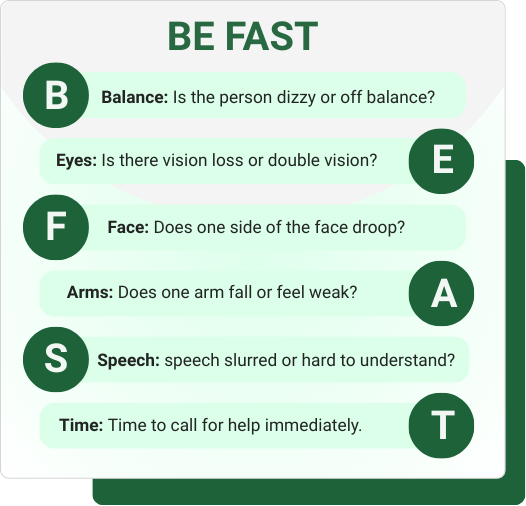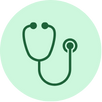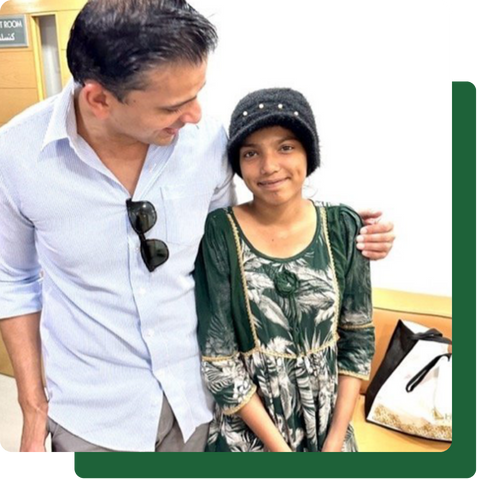Recognizing stroke symptoms early can save lives. Learn how to spot the signs and get the help you need.


When blood flow is blocked or interrupted, brain cells begin to die, and every minute counts. The faster you receive treatment, the more brain tissue can be saved.
If you or someone you know is experiencing these symptoms, do not wait. Call your local emergency services immediately.
The treatment for a stroke depends on the type of stroke (ischemic or hemorrhagic), the severity, and how quickly the patient receives medical attention. Below is a detailed explanation of the treatment steps, including clot-busting medications, thrombectomy, and rehabilitation:
Ischemic Stroke: Caused by a blockage in an artery that supplies blood to the brain (most common).
Hemorrhagic Stroke: Caused by bleeding in or around the brain.
Transient Ischemic Attack (TIA): A temporary blockage, often a warning sign.
Call Emergency Services Immediately – Stroke is a medical emergency.
Fast Transport to Hospital – Ideally to a stroke center.
Imaging – CT scan or MRI to determine the type of stroke.
Tissue Plasminogen Activator (tPA) is the most common drug.
Eligibility:
Must be given within 4.5 hours of symptom onset.
No recent surgery or bleeding disorders.
How it works: Dissolves the clot and restores blood flow.
A catheter is inserted into a blood vessel (usually in the groin) and guided to the brain to physically remove the clot.
Most effective within 6 hours, but can be performed up to 24 hours in selected patients.
Often used in large artery occlusions.
After initial treatment, medications like aspirin, clopidogrel, or warfarin may be prescribed to prevent future strokes.
Discontinue any blood thinners.
Medications to lower blood pressure and reduce brain swelling.
Craniotomy to remove blood and relieve pressure.
Clipping or coiling of aneurysms to prevent further bleeding.
Rehabilitation starts as soon as the patient is stable. It aims to regain independence and improve quality of life.
Regain motor skills, balance, and strength.
Help with daily activities (e.g., dressing, eating).
For speech, language, or swallowing difficulties.
Cognitive training, emotional support, and memory improvement.
Family involvement, lifestyle changes (e.g., smoking cessation, diet, exercise), and prevention of recurrence.
Regular follow-ups with neurologists or stroke specialists.
Secondary prevention:
Manage risk factors (blood pressure, diabetes, cholesterol).
Healthy lifestyle and adherence to medications.
The speed at which stroke treatment begins is absolutely critical—it can mean the difference between full recovery and long-term disability or even death. This is where the concept of the “Golden Hour” comes into play.
The “Golden Hour” refers to the first 60 minutes after the onset of stroke symptoms. It’s called “golden” because treatment during this window has the highest chance of minimizing brain damage and improving outcomes.
During a stroke, the brain loses approximately 1.9 million neurons per minute. The faster treatment is started, the better the chance of saving brain tissue.
tPA (clot-busting drug) is most effective within 3 hours, with some patients eligible up to 4.5 hours.
The sooner it’s administered, the more brain tissue is saved.
Studies show that every 15-minute reduction in treatment time leads to better functional outcomes.
Most effective within 6 hours, but can be extended up to 24 hours in some cases depending on imaging results.
Early imaging and decision-making are key to being eligible.
Equipped with neurologists, imaging, and intervention teams available 24/7.
Can rapidly perform CT or MRI scans to differentiate stroke types.
Offer specialized procedures like tPA administration and mechanical thrombectomy.
Waiting at home for symptoms to pass.
Not recognizing signs of stroke (e.g., slurred speech, facial drooping, arm weakness).
Going to a non-specialized facility first.
Face drooping
Arm weakness
Speech difficulty
Time to call emergency services
Call emergency services immediately – don’t drive yourself.
Note the time symptoms started – it guides treatment eligibility.
Do NOT delay – even if symptoms improve (as in a TIA).
Stay calm but act quickly.
Use the BE FAST acronym to recognize the signs.
Call emergency services immediately (e.g., 911 or your local emergency number).
Note the time symptoms first appeared—this helps doctors decide on treatment.
Do not give them food, drink, or medication unless told by a medical professional.
Keep them safe and comfortable, but don’t let them fall asleep or delay help.
| Letter | Stands For | What to Look For |
|---|---|---|
| B | Balance | Sudden loss of balance or coordination, dizziness |
| E | Eyes | Sudden vision loss or double vision in one or both eyes |
| F | Face Drooping | Ask the person to smile—is one side of their face drooping or numb? |
| A | Arm Weakness | Ask them to raise both arms—does one arm drift downward or feel weak/numb? |
| S | Speech Difficulty | Ask them to speak—is their speech slurred, strange, or hard to understand? |
| T | Time to call | If any signs are present, call emergency services immediately. |
Yes, young people can absolutely have strokes, including children, teens, and adults under 45. While strokes are more common in older adults, the incidence among younger populations is rising—and the impact can be just as severe, if not more life-altering.
Yes. Strokes can occur at any age, even in infants.
Studies show that about 10–15% of all strokes happen in people under 50.
In recent years, stroke rates in young adults (18–45) have been increasing due to lifestyle and health factors.
Many strokes in young adults stem from different causes than in older adults. Some key factors include:
Smoking
Excessive alcohol or drug use (e.g., cocaine, amphetamines)
Poor diet and lack of exercise
Obesity
Hypertension (high blood pressure) – often undiagnosed
Heart disorders, like atrial fibrillation or hole in the heart (PFO)
Blood clotting disorders
Autoimmune diseases (e.g., lupus, antiphospholipid syndrome)
Migraines with aura – linked to higher stroke risk in some studies
Diabetes
Young women have some gender-specific risk factors that can increase stroke risk:
Birth control pills, especially combined with smoking or migraines
Hormone replacement therapy
Preeclampsia and gestational hypertension
Clotting changes during and after pregnancy
Diseases like systemic lupus erythematosus (SLE) are more common in women and can increase stroke risk.
Young people often ignore or delay treatment because they don’t think they’re at risk. But the signs of stroke are the same, no matter your age:
BE FAST (Balance, Eyes, Face, Arms, Speech, Time)
If symptoms appear, call emergency services immediately.
Don’t ignore high blood pressure or migraines.
Stop smoking and reduce alcohol/drug use.
Maintain a healthy weight, diet, and exercise routine.
Manage chronic conditions like diabetes or autoimmune diseases.
Talk to your doctor if you’re on birth control or hormonal medications.
With early intervention, many stroke symptoms can be reversed, and recovery is more likely.
For ischemic strokes, caused by a blocked blood vessel in the brain, tPA (tissue plasminogen activator) is used to dissolve the clot and restore blood flow.
In more severe ischemic strokes, particularly those caused by large artery blockages, a mechanical thrombectomy may be performed.
For hemorrhagic strokes, which involve bleeding in the brain, surgery may be required to relieve pressure and prevent further damage.

Encourage regular exercise, a healthy diet, and quitting smoking.

Emphasize the importance of managing blood pressure, glucose levels, and requires immediate treatment..

Recommend regular health screenings to detect early signs stroke risk factors.
A resident of Larkana Singh until recently was a typical 14-year-old teenage girl in grade 7 who enjoyed listening to Bollywood music and playing with her siblings.
Last month, her world changed. She suddenly developed an intense severe headache, the worst imaginable. Throughout the day, she became tired, lethargic, and couldn’t keep anything down. Her parents, a poor laborer and homemaker, took her to the local district hospital, and a CT scan of the head confirmed bleeding in the brain due to a ruptured brain aneurysm.


The Pakistan Stroke Initiative is dedicated to transforming stroke care in Pakistan by focusing on early stroke intervention, comprehensive physician training, and expanding access to life-saving healthcare services. Our mission is to reduce the burden of stroke-related deaths and disabilities by empowering healthcare professionals, increasing public awareness, and improving the standard of care nationwide.